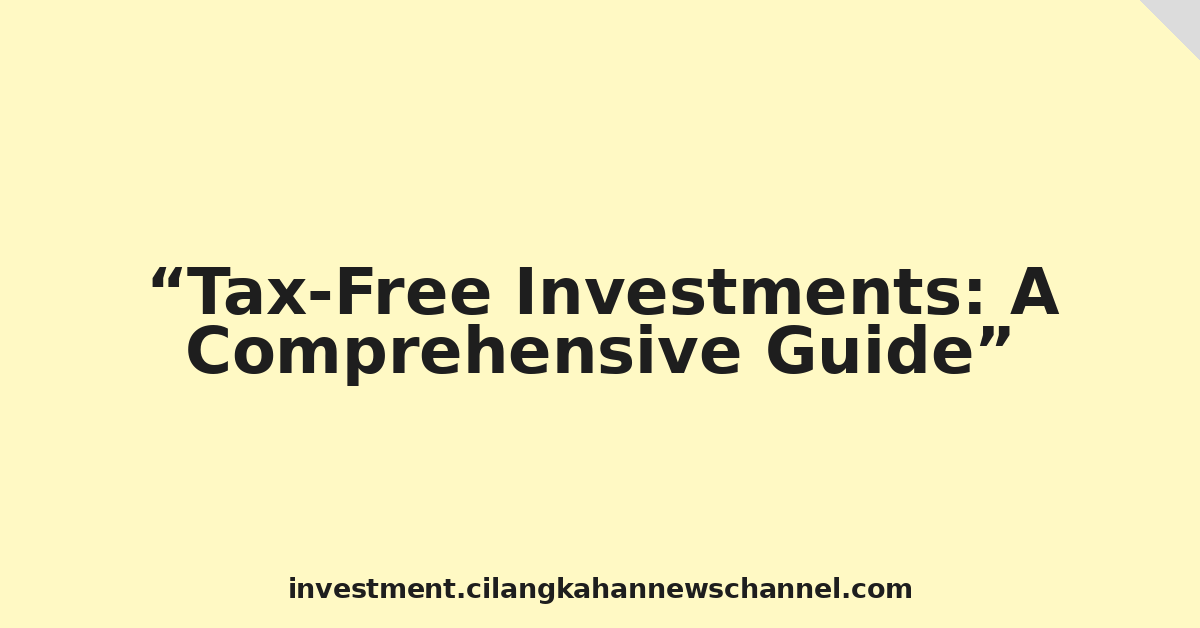Investing your hard-earned money wisely is a crucial step towards securing your financial future. However, the impact of taxes on investment returns can significantly diminish your overall gains. This is where tax-free investments come into play, offering a powerful tool to maximize your returns and build wealth more efficiently. This article delves into the world of tax-free investments, exploring various options, their advantages and disadvantages, and helping you determine which strategies might be best suited for your individual circumstances.
Hello readers of investment.cilangkahannewschannel.com! Understanding the tax implications of your investment choices is paramount to successful wealth building. While many investments are subject to capital gains taxes, dividend taxes, or other levies, tax-free investments offer a compelling alternative, allowing your money to grow without the immediate burden of taxation. This doesn’t mean you’ll never pay taxes on the money, but it significantly defers the tax liability, allowing for potentially greater returns over time. Let’s unpack the different types of tax-free investment options available and explore their nuances.
Types of Tax-Free Investments:
The specific types of tax-free investments available will vary depending on your jurisdiction and the specific regulations in place. However, some common categories include:
1. Tax-Advantaged Retirement Accounts:
These accounts offer significant tax benefits specifically designed to encourage saving for retirement. The most common examples include:
-
401(k)s: Offered by many employers, these plans allow pre-tax contributions, reducing your taxable income in the present. Investment earnings grow tax-deferred, meaning you don’t pay taxes on them until you withdraw them in retirement. Some plans also offer employer matching contributions, essentially providing free money towards your retirement.
-
Traditional IRAs: Individual Retirement Accounts allow individuals to contribute a certain amount annually, reducing their taxable income. Similar to 401(k)s, earnings grow tax-deferred, and withdrawals are taxed in retirement.
-
Roth IRAs: Unlike traditional IRAs, contributions to Roth IRAs are made after tax. However, withdrawals in retirement are tax-free, providing a significant advantage in the long run. This makes them particularly attractive for those who anticipate being in a higher tax bracket in retirement.
-
SEP IRAs: Simplified Employee Pension plans are retirement plans for self-employed individuals and small business owners. Contributions are tax-deductible, and earnings grow tax-deferred.
2. Municipal Bonds:
These bonds are issued by state and local governments to finance public projects such as schools, roads, and hospitals. The interest earned on municipal bonds is typically exempt from federal income tax, and often exempt from state and local taxes as well, depending on your residency. This makes them particularly attractive for investors in higher tax brackets. However, it’s important to note that municipal bonds generally offer lower yields compared to taxable bonds.
3. Tax-Free Savings Accounts (TFSA):
Many countries offer tax-free savings accounts, which allow individuals to contribute a certain amount annually without incurring any taxes on the earnings or withdrawals. The specific contribution limits and rules vary depending on the country and region. These accounts are extremely versatile and can be used for various purposes, including retirement savings, short-term goals, or emergency funds. The tax-free nature of these accounts allows for significant growth potential.
4. Series EE Savings Bonds:
These bonds are offered by the U.S. government and can be purchased at half their face value. The interest earned is exempt from state and local taxes, and can be exempt from federal taxes under certain conditions, such as using the proceeds to pay for higher education expenses.
Advantages of Tax-Free Investments:
-
Higher Net Returns: The most significant advantage is the ability to retain a larger portion of your investment earnings. By avoiding taxes on investment income, your overall returns are significantly enhanced.
-
Compounding Growth: The tax-free nature of these investments allows for compounding to work its magic more effectively. As your investments grow, the earnings are reinvested without being diminished by taxes, leading to exponential growth over time.
-
Long-Term Wealth Building: Tax-free investments are ideally suited for long-term wealth building strategies, allowing you to accumulate a larger nest egg for retirement or other significant life goals.
-
Reduced Tax Liability: By strategically utilizing tax-free investments, you can significantly reduce your overall tax liability, potentially freeing up more funds for other financial goals.
Disadvantages of Tax-Free Investments:
-
Limited Investment Choices: The range of investment options available within tax-advantaged accounts might be more restricted compared to taxable accounts.
-
Contribution Limits: Many tax-free investment accounts have annual contribution limits, restricting the amount you can contribute each year.
-
Withdrawal Restrictions: Early withdrawals from certain tax-advantaged accounts, such as retirement accounts, can result in penalties and taxes.
-
Lower Potential Returns (in some cases): Some tax-free investments, like municipal bonds, might offer lower yields compared to taxable investments. This trade-off needs to be carefully considered based on your individual risk tolerance and financial goals.
Choosing the Right Tax-Free Investment Strategy:
Selecting the appropriate tax-free investment strategy depends on various factors, including:
-
Your Age and Retirement Goals: Retirement accounts are ideal for long-term savings, while TFSA’s can be more flexible for various short-term and long-term goals.
-
Your Income Level: High-income earners might benefit more from tax-advantaged accounts that reduce their current tax burden.
-
Your Risk Tolerance: Your investment choices within tax-free accounts should align with your overall risk tolerance.
-
Your Financial Goals: Consider your specific financial goals, whether it’s retirement, education, or other significant life events.
Conclusion:
Tax-free investments are a powerful tool for building wealth and maximizing your investment returns. By understanding the various options available and carefully considering your individual circumstances, you can develop a comprehensive investment strategy that allows your money to grow efficiently and effectively. Remember to consult with a qualified financial advisor to determine the best approach for your specific needs and goals. They can help you navigate the complexities of tax laws and develop a personalized plan that aligns with your long-term financial aspirations. Don’t let taxes eat away at your hard-earned gains – harness the power of tax-free investments to achieve your financial dreams.

